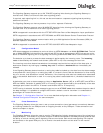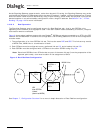
11
Dialogic
®
SS7G2x Signaling Server SGW Mode User Manual Issue 4
The Signaling Gateway supports up to 128 TDM SS7 signaling links allowing the Signaling Gateway to
interface over TDM to a maximum of 64 other signaling points.
If required, each signaling link in a link set can be terminated on a separate signaling board providing
additional resilience.
The Signaling Gateway can have a presence in up to four separate IP subnets.
The Signaling Gateway supports up to 32 M2PA SS7 signaling links, allowing the Signaling Gateway to
interface over IP to a maximum of 32 other signaling points.
M2PA is supported in accordance with the IETF SS7 MTP2-User Peer-to-Peer Adaptation Layer specification.
SCTP is supported in accordance with IETF RFC 2960 and RFC 3309 Stream Control Transmission Protocol.
The Signaling Gateway supports communication with up to 200 Application Servers Processes (ASPs) for
backhaul operation over M3UA.
M3UA is supported in accordance with the IETF RFC 3332 SS7 MTP3 User Adaptation Layer.
1.9.2 Configuration Model
MTP data messages are considered to arrive at either an MTP3 link set or an M3UA SIGTRAN link. The link
set or M3UA SIGTRAN link identifies the network and SS7 format of the message. MTP3 link sets can exist
above a TDM MTP2 signaling link or a signaling link utilizing a M2PA SIGTRAN link for communication over IP.
The decision as to how to process the data message is performed by the incoming route. The incoming
route is identified by the network and domain (either MTP or IP) that a message arrives from.
The incoming route then determines whether the message requires further analysis of the data prior to
destination selection by looking up a routing key table or whether a destination can immediately be
selected.
If the Signaling Gateway determines that a routing key table be looked up, the data from the data message
is compared with routing keys in a routing key table. If a match is found, and the destination for that routing
key is in service, that destination is used. Otherwise, if the incoming route also has a destination associated
with it, that default destination is used. If no routing key table is associated with it, the default destination is
used.
A destination can route a data message to either an Application Server (AS) or to MTP (MTP over MTP2 or
MTP over M2PA). Selection of whether MTP or IP routing is used is determined by the availability of the data
messages point code in the MTP or IP domain and whether MTP or IP has priority.
If MTP routing is selected, the data message is sent out on an MTP SS7 route that matches the point code of
the data message. It is possible to configure MTP3 with a default route for use when it is undesirable to
preconfigure all routes that are used.
See Chapter 7, “Configuration Overview” for a more detailed configuration discussion and Chapter 11,
“Worked Configuration Examples” for some examples.
1.9.3 Cross Connections
The Signaling Gateway allows the user to set up cross connections (semi-permanent connections) between
an incoming timeslot on one PCM port and an outgoing timeslot on any PCM port. These connections can
either be simplex or duplex.
1.9.4 Monitoring
The Signaling Gateway allows the user to monitor TDM signaling links by dropping a copy of the signaling to
a spare PCM port. This allows for a protocol analyzer to be left connected to one PCM port and gives the user
the ability to control remotely which signaling links are monitored. Each monitored signaling link requires
two timeslots on the spare PCM port, one to monitor the send direction and the other for the receive
direction.


















